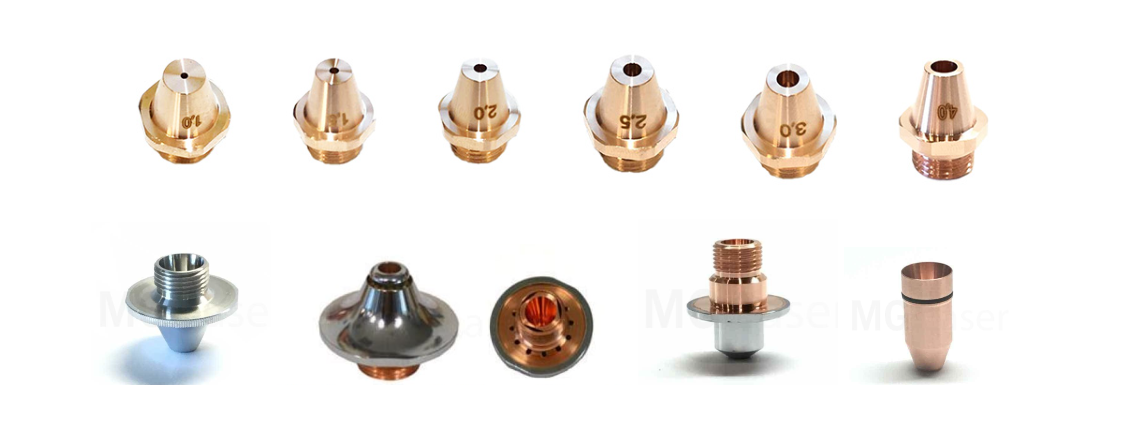
How to Choose a Nozzle Tip for Your Laser
Introduction
Nozzle tip design can be complicated, but choosing the correct nozzle tip for your application doesn't need to be.
The best place to start? The manufacturer of your CO2 or Fiber laser usually provides recommendations for selecting the appropriate nozzle tip size for different materials and thicknesses. However, if you have an older machine, there might be some new options available such as chrome plating and double nozzle versions.
Different characteristics to consider when choosing a nozzle tip include the following: orifice size, chrome or non-chrome plating, single or double nozzle, and the surface area of the nozzle near the cutting area. In some cases, there are also options for internal shapes that affect the assist gas flow, such as conical or cylindrical. The following is a basic overview of these different nozzle options.
Orifice Size
In general, thinner material will use a smaller nozzle orifice size, and thicker material will use a larger nozzle orifice size. The below tables are a guide, not a rule, but provide a basic starting point. An experienced operator can make other nozzle sizes work well with a different combination of feed rate, laser power, and assist gas pressure. The values in these tables are for lasers up to 4,000 watts. Modern fiber lasers are now available with much higher wattages and can use much larger diameter orifices.
|
Mild Steel
|
Oxygen cutting
|
|
Thickness
|
|
|
Up to .25"
|
1.2 or 1.5mm
|
|
.25 - .50"
|
2.0mm
|
|
.50 - 1.0"
|
2.5 or 3.0mm
|
|
Stainless Steel
|
Nitrogen cutting
|
|
Thickness
|
|
|
Up to .048"
|
1.2 or 1.5mm
|
|
.048 - .160"
|
2.0mm
|
|
.160 - .50"
|
3.0mm
|
Below is an image showing the differences in nozzle orifice sizes:

Chrome Plating
Most nozzles are available now with chrome plating, which helps further extend the life of the nozzle. The chrome finish provides a harder surface that is more durable and has a stronger resistance to metal spatter. Some laser manufacturers now offer chrome-plated nozzles as the only option, however, not all nozzles are available with chrome plating. Chrome-plated nozzles are slightly more expensive but are often worth the cost because of their longer lifetime.
Below are examples of copper (left) vs. chrome-plated (right) nozzles:

Single Layer Vs. Double Layer Nozzles
Double nozzles are often used when cutting mild steel that is 1/4" or thicker and using oxygen as an assist gas. The double nozzle results in an edge quality that will be a smoother cut. Double nozzles have an insert inside that separates the flow of the assist gas to force the gas to come out of the nozzle through sections inside the nozzle. The flow of assist gas through a double nozzle is more level, which leads to a smoother edge quality than that of a standard single nozzle. Double nozzles are not usually used when cutting with high-pressure assist gases such as nitrogen because the insert inside the nozzle will restrict the flow of the gas.
The diagram below shows how the inside of a double nozzle looks and how it affects the gas flow.

The pictures below show the double-layer insert from different perspectives. The nozzle on the left is a double nozzle, and the one on the right is a single-layer nozzle. The left image shows a top view, and the right image shows a bottom view.

Nozzle Tip Shape
Nozzles come in many shapes and sizes for laser cutting. Some nozzles have a very narrow shape at the bottom where material processing takes place. Wider nozzles typically last longer because they are able to absorb more heat. Some laser models have only one option for the nozzle shape. Below are a few examples of different nozzle shapes that are available on some different Mazak laser models.
- The three nozzles below are all compatible with the Mazak models HG, HTX, Mark III, and Optiplex. The nozzle on the left is a shorter length, so it does require an adaptor to offset that length.

Bottom View:

- The three nozzles below are all compatible with the Mazak models Mark II, NTX, and STC-SC. The nozzle on the right requires an extra calibration of the non-contact amplifier to make it compatible, which is typically done by a technician.

Conical Vs. Cylindrical
Nozzles with a cylindrical internal geometry are used for low-pressure assist gas cutting, most commonly when cutting mild steel with oxygen as the assist gas.
Nozzles with a conical internal geometry are used for high-pressure assist gas cutting, most commonly when cutting stainless steel or aluminum with nitrogen as the assist gas.
Not all models of lasers have the option to use a conical or cylindrical nozzle, but oftentimes the nozzle name will include "conical" or "cylindrical" to help identify the internal shape. It is important to keep this in mind as you are purchasing new nozzles. For example, if you are cutting stainless steel with high-pressure nitrogen and have a nozzle with "cylindrical" in the nozzle name, the quality of your cut will not be as good as if you were using a "conical" nozzle.

